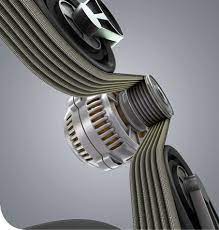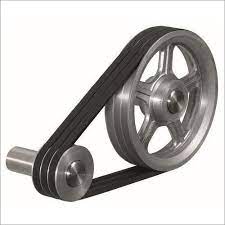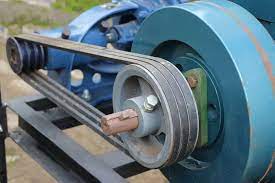Product Description
Drive Pulley/Belt Conveyor Pulley/Tail Pulley
Type of Conveyor Pulley:
Conveyor tail pulley
Conveyor head pulley
Conveyor rubber lagging pulley
Conveyor steel pulley
Conveyor driving pulley
Conveyor turnaround pulley
Pattern conveyor pulley
Conveyor pulley
Rubber conveyor pulley
Head pulley etc.
Conveyor Head Tail pulley:
Head pulley can be divided into driving pulley (head pulley) and thurn about pulley (tail pulley), driving pulley is the main part for transmitting the power: Smooth surface and rubber surface, and rubber surface can be classified into smooth rubber surface, herringbone rubber surface and CHINAMFG rubber surface to meet different technical requirements. Averting pulley can be classified into smooth rubber surface and smooth steel surface.
Construction
All the pulley adopt integrated bearing housing which is lubricated and filled with grease and has 2 kinds: Iron casting and steel casting, the shaft is made of 45#steel, the shell adopt weld assembly.
Huayue Conveyor Pulley Specification:
1. Pulley Diameter: 250-1800mm.
2. Belt width: 300mm to 2400mm.
3. Length: Depend on the belt width.
4. Welding: Carbon dioxide arc welding, argon arc welding, electrode welding etc.; In accordance with AWS standard or substitute welding standard
5. Lagging: Cold lagging; Hot vulcanized lagging, ceramic lagging
6. Pulley tube material: Q235 seamless carbon steel.
7. Professional pulley production line.
8. Professional designing and inspection team.
9. Certification: ISO, BV, etc
Our best quality based on:
Manufacturer
Experience in Cooperate with Fortune 500 Companies
Professional Engineering Capability
Stable Quality
Reasonable Price
Small Orders Accepted
Continuous Improvements
High Product Performance
Prompt Delivery
Professional Service
For more details, please inquiry us!
Polyester conveyor belt, (EP)
Nylon conveyor belt, (NN)
Cotton conveyor belt, (CC)
Sidewall conveyor belt (SW)
Steel Cord conveyor belt ( ST )
Chevron conveyor belt, (C5 C10 and C15)
Oil Resistance conveyor belt, (OR and MOR)
Hot Resistance conveyor belt, (HR)
Fire Resistance conveyor belt, (FR/PVC/PVG)
Heat Resistance conveyor belt, (HR/ FR)
Cold Resistance conveyor belts, (CR)
Pattern conveyor belt ( 30+ Moulds)
Metal Mesh conveyor belt (Heat resistant temp until 800c)
Endless belts
Conveyor roller, idler
Conveyor Pulley, frame, bracket etc
| Type | Belt width (mm) | Standard Diameter(mm) | Length (mm) |
| Drive Head Pulley | 500 | 500 | Length of the pulley depends on the belt width of the conveyor |
| 650 | 500, 630 | ||
| 800 | 500, 630, 800 | ||
| 1000 | 630, 800, 1000 | ||
| 1200 | 630, 800, 1000 | ||
| 1400 | 800, 1000 | ||
| Tail Pulley | 500 | 250, 315, 400, 500 | |
| 650 | 250, 315, 400, 500 | ||
| 800 | 250, 315, 400, 500, 630, 800, 1000 | ||
| 1000 | 250, 315, 400, 500, 630, 800, 1000 | ||
| 1200 | 250, 315, 400, 500, 630, 800, 1000 | ||
| 1400 | 250, 315, 400, 500, 630, 800, 1000 |
| Type: | Handling Machinery |
|---|---|
| Structure: | Belt Conveyor |
| Material: | 45# Steel, Rubber and etc |
| Material Feature: | Oil Resistant |
| Color: | Available |
| Condition: | New |
| Samples: |
US$ 200/Piece
1 Piece(Min.Order) | |
|---|
| Customization: |
Available
| Customized Request |
|---|

What are some real-world examples of drive belt pulley applications in various industries?
There are numerous real-world examples of drive belt pulley applications across various industries. Here’s a detailed explanation of some common examples:
1. Automotive Industry:
– Engine Systems: Drive belt pulleys are used in automotive engines to transmit power from the crankshaft to various engine accessories, such as the alternator, power steering pump, water pump, and air conditioning compressor. These pulleys ensure the proper functioning of these components and provide efficient power distribution in the engine system.
– Timing Systems: Timing pulleys and belts are employed in automotive engines to synchronize the rotation of the camshaft and crankshaft. This precise timing is crucial for the opening and closing of engine valves in coordination with the piston movement, ensuring optimal engine performance and fuel efficiency.
2. Industrial Machinery:
– Conveyor Systems: Drive belt pulleys are utilized in conveyor systems to transfer power from motors to conveyor belts. They enable the movement of materials, products, or components along the conveyor line, facilitating efficient material handling in industries such as manufacturing, logistics, and mining.
– Machine Tools: Drive belt pulleys are found in various machine tools, such as lathes, milling machines, and drills, to transmit power from the motor to the spindle or cutting tool. These pulleys allow for precise speed control and power transmission, ensuring accurate machining operations.
– Printing Presses: Timing pulleys and belts are used in printing presses to synchronize the movement of printing plates, ensuring precise registration and consistent print quality. The pulleys enable accurate timing and reliable power transmission for the complex mechanisms involved in the printing process.
3. HVAC Systems:
– Air Handling Units: Drive belt pulleys are employed in air handling units to drive fans and blowers that circulate air in heating, ventilation, and air conditioning (HVAC) systems. These pulleys enable efficient airflow and temperature control in commercial and residential buildings.
4. Agricultural Machinery:
– Tractors and Farm Equipment: Drive belt pulleys are used in tractors and various farm equipment to transfer power from the engine to components such as pumps, augers, conveyors, and cutting mechanisms. These pulleys enable tasks like plowing, planting, harvesting, and material handling in agricultural operations.
– Harvesting Machinery: Agricultural machinery like combines and forage harvesters employ drive belt pulleys to power the cutting mechanisms, threshing systems, and grain separation mechanisms. These pulleys ensure efficient harvesting and grain processing in the agricultural industry.
5. Fitness Equipment:
– Treadmills and Exercise Bikes: Drive belt pulleys are utilized in fitness equipment like treadmills and exercise bikes to transfer power from the motor to the running belt or pedals. These pulleys allow for adjustable speed control and smooth operation, providing users with an effective workout experience.
6. Construction Equipment:
– Concrete Mixers: Drive belt pulleys are used in concrete mixers to transmit power from the engine to the mixing drum. These pulleys enable efficient mixing of concrete during construction projects, ensuring uniformity and consistency in concrete production.
– Cranes and Hoists: Drive belt pulleys can be found in cranes and hoists to transmit power from the motor to the lifting mechanisms. These pulleys provide the necessary torque and speed control for lifting heavy loads in construction sites and industrial settings.
These examples highlight the wide range of applications of drive belt pulleys across industries, from automotive and industrial machinery to HVAC, agriculture, fitness equipment, and construction. Drive belt pulleys play a crucial role in power transmission, speed control, and reliable operation in various mechanical systems, contributing to the efficiency and functionality of these industries.

What role do drive belt pulleys play in air conditioning and alternator systems?
Drive belt pulleys play a crucial role in both air conditioning and alternator systems in automotive applications. Here’s a detailed explanation of the role drive belt pulleys play in these systems:
Air Conditioning System:
In an automotive air conditioning system, the drive belt pulley is responsible for transmitting power from the engine’s crankshaft to the air conditioning compressor. The air conditioning compressor is a key component that pressurizes and circulates the refrigerant throughout the system, allowing for the cooling and dehumidification of the air inside the vehicle’s cabin.
The drive belt pulley is connected to the engine’s crankshaft, and as the engine rotates, it drives the pulley, which in turn spins the air conditioning compressor. This rotational motion of the compressor enables it to compress and circulate the refrigerant, absorbing heat from the cabin and releasing it outside, resulting in the cooling effect.
By driving the air conditioning compressor, the drive belt pulley ensures the proper functioning of the air conditioning system. It allows for the regulation of the compressor’s speed and power output, controlling the cooling capacity of the system based on the cabin temperature and the desired comfort level.
Alternator System:
In an automotive alternator system, the drive belt pulley is responsible for driving the alternator, which is a critical component for generating electrical power and charging the vehicle’s battery. The alternator converts mechanical energy from the engine’s rotation into electrical energy, supplying power to the electrical systems and recharging the battery while the engine is running.
The drive belt pulley is connected to the engine’s crankshaft, and as the engine rotates, it drives the pulley, which in turn spins the alternator. The rotational motion of the pulley drives the alternator’s internal rotor, which is surrounded by a stator and a set of windings. This relative motion between the rotor and stator induces an electrical current in the windings, generating the electrical power output.
The drive belt pulley ensures that the alternator operates at the correct speed and power output to meet the electrical demands of the vehicle. It provides the necessary mechanical power to drive the alternator and generate the required electrical energy, supplying power to the vehicle’s electrical systems, including the lights, ignition system, audio system, and various other electronic components.
Additionally, the drive belt pulley in the alternator system plays a role in the battery charging process. As the alternator generates electrical power, it also recharges the vehicle’s battery, ensuring that it remains charged and ready to supply electrical energy when the engine is not running or when the electrical load exceeds the alternator’s output capacity.
Overall, drive belt pulleys are essential components in both air conditioning and alternator systems in automotive applications. They facilitate the transfer of power from the engine’s crankshaft to the air conditioning compressor and alternator, enabling the proper functioning of these systems and ensuring the comfort and electrical reliability of the vehicle.

Can you explain the key components and design features of a drive belt pulley?
A drive belt pulley consists of several key components and design features that enable its efficient operation and power transmission. Here’s a detailed explanation of these components and features:
1. Pulley Wheel:
The pulley wheel is the main component of a drive belt pulley. It is typically a cylindrical or disk-shaped wheel with a grooved rim. The wheel is designed to accommodate the belt and provide a surface for power transmission. The grooves on the rim match the shape and size of the belt, ensuring a secure fit and optimal power transfer.
2. Grooves:
The grooves on the pulley wheel’s rim are an essential design feature. They provide the necessary contact points for the belt, ensuring a firm grip and preventing slippage during power transmission. The grooves can have different shapes, such as V-shaped or multi-ribbed, depending on the type of belt used.
3. Belt Alignment Guides:
Drive belt pulleys often include alignment guides to ensure proper positioning and alignment of the belt. These guides can be raised ridges or flanges located on the sides of the pulley. They help keep the belt in place and prevent it from slipping off the pulley, especially in high-tension applications.
4. Hub or Bore:
The hub or bore is the central opening in the pulley wheel where it attaches to the shaft of the power source. The hub is typically designed to fit snugly onto the shaft, ensuring a secure connection and efficient power transfer. It may include keyways, splines, or set screws to prevent rotation or slippage on the shaft.
5. Material and Construction:
Drive belt pulleys are commonly made of durable materials such as metal or plastic. Metal pulleys, such as steel or cast iron, are favored for their strength and resistance to wear. Plastic pulleys, often made of reinforced nylon or polyurethane, are lightweight, corrosion-resistant, and suitable for applications where reduced noise and vibration are desired.
6. Size and Diameter:
The size and diameter of the drive belt pulley play a crucial role in determining the speed ratio and power transmission characteristics. By altering the diameter or using pulleys of different sizes, the rotational speed and torque can be adjusted to meet specific requirements. Different pulleys within a system may have varying diameters to create speed variation or torque multiplication.
7. Tensioning Mechanism:
In some applications, drive belt pulleys may incorporate a tensioning mechanism. This mechanism allows for the adjustment of belt tension to ensure proper power transmission and prevent slippage. Tensioning mechanisms can include spring-loaded arms, adjustable brackets, or sliding mounts that enable easy tension adjustment and maintenance.
8. Bearing or Bushing:
Drive belt pulleys often include bearings or bushings to facilitate smooth and efficient rotation. These components reduce friction between the pulley and the shaft, allowing for improved power transmission and longevity of the pulley system. Bearings can be ball bearings, roller bearings, or plain bushings depending on the specific application and load requirements.
These key components and design features collectively contribute to the functionality, reliability, and performance of drive belt pulleys. By providing a secure fit for the belt, maintaining proper alignment, accommodating tension adjustments, and utilizing durable materials, drive belt pulleys ensure efficient power transmission and contribute to the smooth operation of mechanical systems in various applications.


editor by CX
2023-09-28